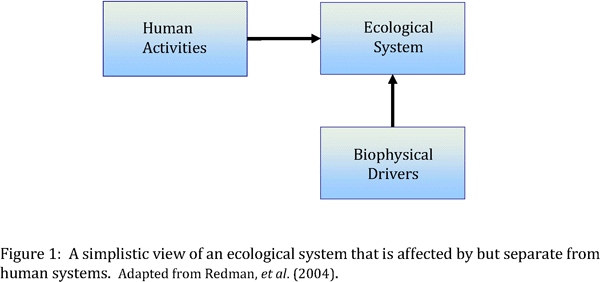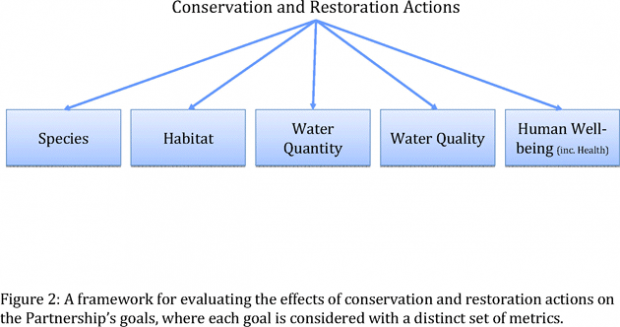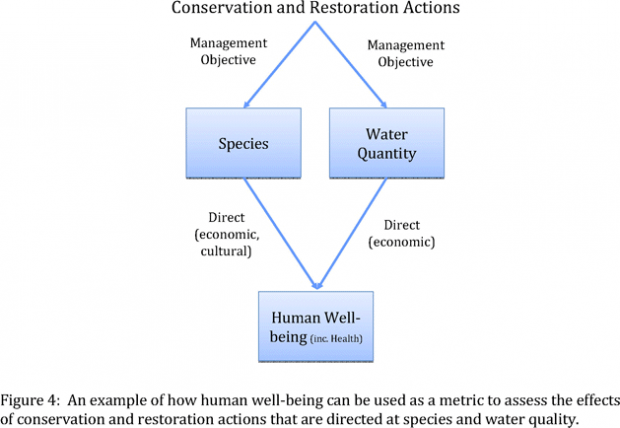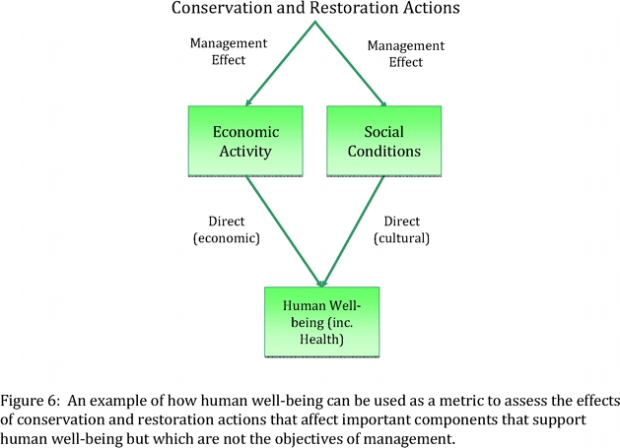Over the past decade, efforts have been made to expand our understanding of coupled social and ecological systems (Millennium Ecosystem Assessment, 2003; Liu et al., 2007; Walker et al., 2002). Governments at many levels have increasingly sought to base environmental management not just on political considerations, but on goals such as ecological health and resilience. Understanding how the two systems are linked is therefore important. The links between biophysical and human systems, and the support that the biophysical systems provide for human well-being, are both obvious and obviously important. The systematic measurement and assessment of the existence and importance of individual links, however, is less common than simple assertions that such links exist (Bowen and Riley 2003).
Crafting a picture of a linked natural-human system often takes place in the context of ecosystem-based management. In its early conception, EBM was defined to mean "focusing on ecological systems that may cross administrative and political boundaries, incorporating a ‘system' perspective sensitive to issues of scale, and managing for ecological integrity" (Endter-Wada, 1998). This initial definition was an ecologically centered view with human systems incorporated simply as political boundaries or more complexly as impacts on the system to be controlled or reduced (Figure 1).

Although the purely ecocentric view still exists, there has been increasing recognition of the need to integrate humans and our social systems more completely into the EBM framework. The common approach to EBM has expanded to include the need to manage for the sustainability of human systems as well as ecological communities, to practice adaptive management, and to encourage broad-based involvement and collaboration in implementing EBM. As the term is employed in the Puget Sound region, EBM includes the management of ecosystems in ways that are inclusive of human needs and values, as reflected in the six goals listed in the previous section.
This section provides a conceptual model of how human well-being can be integrated into the Partnership’s framework for conducting EBM. This model can also be used to craft a strategy for identifying and evaluating the connections between indicators, biophysical and human-based, and human well-being in the context of the Puget Sound Partnership’s tasks. By including human well-being (along with human health) as an explicit goal, the Partnership acknowledges the importance of this integrated view. Including indicators that measure impacts to both the human and biophysical systems will therefore provide stronger support for an EBM effort such as the one being pursued by the Partnership (Bowen and Riley, 2003; Carr et al 2007). Bringing HWB into an ecosystem-based management effort has potentially deeper implications, however. The Partnership goals can sometimes conflict with one another, and so the question arises of how to assess and evaluate such conflicts. The current Partnership approach is to compartmentalize the six goals and discuss them separately. Examples of this include the Partnership's Ecosystem Status & Trends document (Puget Sound Partnership, 2009a) and the Identification of Ecosystem Components and Their Indicators and Targets technical memorandum (Puget Sound Partnership, 2009b), where each goal is discussed separately. Connections among the systems represented by the goals are recognized, of course, but the question of how to resolve potential conflicts has not yet been addressed.
Separating ecological goals from human well-being is apparently one way of resolving a long standing tension between adopting a wholly ecocentric or wholly anthropocentric viewpoint in ecosystem-based management (Endter-Wada et al., 1998, for a discussion of this tension). Still, by setting the two sets of goals apart, the Partnership implicitly grants the ecological goals something in the nature of intrinsic value. That is, species, habitat, water quality, and water quantity have value for their own sake; or, it may be that some aspect of a particular goal has value because of its support for aspects of the other natural goals (e.g., the value of nearshore habitat may be derived from its support for certain species), but the goals so supported are still valued for their own sake.
Figure 2 gives a representation of this approach, where actions drawn from the Partnership's Action Agenda can be evaluated in terms of changes to one or more of the Partnership goals (Puget Sound Partnership, 2008). A problem with this construction is the difficulty it creates when intrinsically valued goals conflict with one another or, in this case, with human well-being (Justus et al., 2009). Little guidance is given about which goal should take precedence, and so the resolution of conflicts is hard to assess in a consistent, reasoned way. In contrast, viewing the values involved as instrumental creates an opportunity to evaluate goals with a common metric, because each goal is viewed as an "instrument" in achieving some higher, over-arching goal (Justus et al., 2009).

In the context of the Puget Sound Partnership, human well-being can be used as such an over-arching goal (Figure 3). Now, the ecological goals are viewed as instrumental in supporting human well-being, which then becomes in principle a common metric by which to assess management actions. "Instrumental" does not mean material or based solely on monetary values. As noted by Justus et al. (2009), something has instrumental value to the extent that it is "considered valuable by valuers" - that is, in the context of EBM, it is something that humans value about the environment. This includes values that are independent of consumption or the use of a resource, for example, and can even involve actions that are to the material detriment of the valuer.

Using this framework, it is straightforward to consider different types of links that connect the ecological goals to HWB, and therefore the different types of instrumental values. In Figure 4, the management objective is to improve the conditions covered by the Species and Water Quantity goals. These goals have direct connections to HWB but through possibly multiple types of values. Figure 5 illustrates a different case, where the ecological goal of Habitat provides indirect value to humans through its ecological connections to the Species and Water Quality goals. Assessing the value in this case would require an understanding of 1) the effect of the action on habitat; 2) the effects of habitat changes on species and water quality; and 3) the value to humans of the resulting changes in the conditions of those two goals.


Creating the links between the Partnership's ecological goals and HWB also points to a more expansive view of the set of relevant indicators. Improving ecological systems is not the only way to improve human well-being (Millennium Ecosystem Assessment, 2005). Many factors support human well-being, only some of which are related to or derived from ecological systems. As Dasgupta (2001) notes, a society's total collection of capital is what supports its well-being. This capital is a diverse collection of traditional forms of capital (buildings and machines), "natural" capital (species and habitats), social capital (examples), and other forms. These forms of capital are partly substitutable for one another, and improvement in human well-being is then possible even if one or two components of total capital decrease (Millennium Ecosystem Assessment, 2005).
Figure 6 shows a simple way of expanding the focus of EBM to encompass other forms of capital that support HWB. In this simple illustration, Economic Activity and Social Conditions are treated as broader social goals because they support human well-being. They are not necessarily objectives for the Partnership's management strategies, however, but are certainly affected by them. Because they have strong links to HWB, assessing the effects on these areas will likely improve management, at least in the case where HWB is used as a common metric. Figure 7 illustrates this by presenting the case where an action improves Habitat by constraining Economic Activity. HWB is enhanced by the first effect through the improvements in the Species and Water Quality goals, but the constraint on Economic Activity can produce an offsetting negative effect. Accounting for both types of pathways between actions and HWB is necessary to evaluate the total effect of an action.


The framework illustrated in this section can be used to set priorities for actions and help select indicators. The simplicity of the figures, however, masks the incredible number of all the possible pathways that connect HWB to the conservation and restoration actions proposed by the Partnership. The following two sections address this problem. In section 3, we discuss the nature of human well-being and the traditional indicators that have been used to track and register changes in well-being. In section 4, we consider ways in which the various pathways could be evaluated in terms of the “strength” of the connections. Much of that evaluation lies outside the scope of this report, as it involves identifying and evaluating ecological indicators. The discussion in that section considers different approaches for assessing the strength of connections between human well-being and environmental attributes that have direct effects on well-being.
|
Key Points: Human well-being is both a goal for the Puget Sound Partnership and a potential metric for assessing the effects of conservation and restoration actions that further all Partnership goals. |
References
Bowen, R.E., and C. Riley. 2003. Socio-economic indicators and integrated coastal management. Ocean and Coastal Management 46: 299-312.
Carr, E.R., et al. 2007. Applying DPSIR to Sustainable Development. International Journal of Sustainable Development and World Ecology 14 (6) 543-555.
Dasgupta, P. 2001. Human well-being and the natural environment. Oxford: Oxford University Press.
Endter-Wada, J., D. Blahna, R. Krannich, and M. Brunson. 1998. A Framework For Understanding Social Science Contributions To Ecosystem Management. Ecological Applications 8: 891–904.
Justus, J., M. Colyvan, H. Regan, and L. Maguire. 2009. Buying into conservation: intrinsic versus instrumental value. Trends in Ecology and Evolution 24:187–191.
Liu, J., T. Dietz, S. Carpenter, M. Alberti, C. Folke, E. Moran, A. Pell, P. Deadman, T. Kratz, J. Lubchenco, E. Ostrom, Z. Ouyang, W. Provencher, C. Redman, S. Schneider, and W. Taylor. 2007. Complexity of Coupled Human and Natural Systems. Science 317: 1513-1516.
Millennium Ecosystem Assessment. 2003. Ecosystems and Human Well-being: A Framework for Assessment. Island Press, Washington, D.C.
Millenium Ecosystem Assessment. 2005. Linking ecosystem services and human well-being. In: Capistrano, D., C.K. Samper, M.J. Lee, and C. Raudsepp-Hearne, eds. Ecosystem and Human Well-being: Multiscale Assessment. Island Press, Washington, D.C. pp. 45–60.
Puget Sound Partnership. 2008. Puget Sound Action Agenda, Protecting and Restoring the Puget Sound Ecosystem by 2020. Olympia, WA.
Puget Sound Partnership. 2009a. Ecosystem Status & Trends: A 2009 Supplement to State of the Sound Reporting. Olympia, WA.
Puget Sound Partnership. 2009b. Identification of Ecosystem Components and Their Indicators and Targets. Technical Memorandum, Olympia, WA.
Walker, B., S. Carpenter, J. Anderies, N. Abel, G. S. Cumming, M. Janssen, L. Lebel, J. Norberg, G. D. Peterson, and R. Pritchard. 2002. Resilience management in social-ecological systems: a working hypothesis for a participatory approach. Conservation Ecology 6(1): 14.








